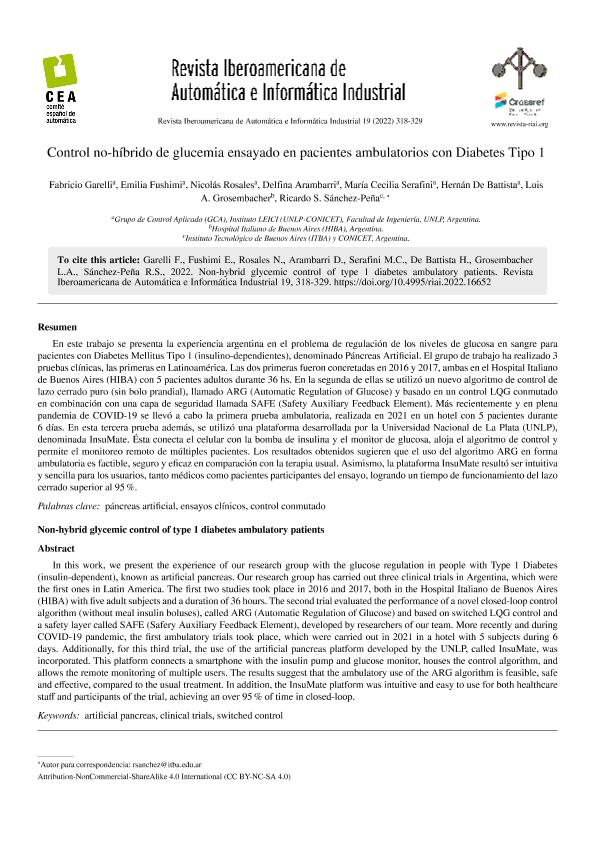Artículo
In this work, we present the experience of our research group with the glucose regulation in people with Type 1 Diabetes (insulin-dependent), known as artificial pancreas. Our research group has carried out three clinical trials in Argentina, which were the first ones in Latin America. The first two studies took place in 2016 and 2017, both in the Hospital Italiano de Buenos Aires (HIBA) with five adult subjects and a duration of 36 hours. The second trial evaluated the performance of a novel closed-loop control algorithm (without meal insulin boluses), called ARG (Automatic Regulation of Glucose) and based on switched LQG control and a safety layer called SAFE (Safery Auxiliary Feedback Element), developed by researchers of our team. More recently and during COVID-19 pandemic, the first ambulatory trials took place, which were carried out in 2021 in a hotel with 5 subjects during 6 days. Additionally, for this third trial, the use of the artificial pancreas platform developed by the UNLP, called InsuMate, was incorporated. This platform connects a smartphone with the insulin pump and glucose monitor, houses the control algorithm, and allows the remote monitoring of multiple users. The results suggest that the ambulatory use of the ARG algorithm is feasible, safe and effective, compared to the usual treatment. In addition, the InsuMate platform was intuitive and easy to use for both healthcare staff and participants of the trial, achieving an over 95 % of time in closed-loop. En este trabajo se presenta la experiencia argentina en el problema de regulación de los niveles de glucosa en sangre para pacientes con Diabetes Mellitus Tipo 1 (insulino-dependientes), denominado Páncreas Artificial. El grupo de trabajo ha realizado 3 pruebas clínicas, las primeras en Latinoamérica. Las dos primeras fueron concretadas en 2016 y 2017, ambas en el Hospital Italiano de Buenos Aires (HIBA) con 5 pacientes adultos durante 36 hs. En la segunda de ellas se utilizó un nuevo algoritmo de control de lazo cerrado puro (sin bolo prandial), llamado ARG (Automatic Regulation of Glucose) y basado en un control LQG conmutado en combinación con una capa de seguridad llamada SAFE (Safety Auxiliary Feedback Element). Más recientemente y en plena pandemia de COVID-19 se llevó a cabo la primera prueba ambulatoria, realizada en 2021 en un hotel con 5 pacientes durante 6 días. En esta tercera prueba además, se utilizó una plataforma desarrollada por la Universidad Nacional de La Plata (UNLP), denominada InsuMate. Ésta conecta el celular con la bomba de insulina y el monitor de glucosa, aloja el algoritmo de control y permite el monitoreo remoto de múltiples pacientes. Los resultados obtenidos sugieren que el uso del algoritmo ARG en forma ambulatoria es factible, seguro y eficaz en comparación con la terapia usual. Asimismo, la plataforma InsuMate resultó ser intuitiva y sencilla para los usuarios, tanto médicos como pacientes participantes del ensayo, logrando un tiempo de funcionamiento del lazo cerrado superior al 95 %.
Non-hybrid glycemic control of type 1 diabetes ambulatory patients
Título:
Control no-híbrido de glucemia ensayado en pacientes ambulatorios con Diabetes Tipo 1
Garelli, Fabricio ; Fushimi, Emilia
; Fushimi, Emilia ; Rosales, Nicolás
; Rosales, Nicolás ; Arambarri, Delfina
; Arambarri, Delfina ; Serafini, María Cecilia
; Serafini, María Cecilia ; de Battista, Hernán
; de Battista, Hernán ; Grosembacher, Luis A.; Sánchez-Peña, Ricardo S.
; Grosembacher, Luis A.; Sánchez-Peña, Ricardo S.
 ; Fushimi, Emilia
; Fushimi, Emilia ; Rosales, Nicolás
; Rosales, Nicolás ; Arambarri, Delfina
; Arambarri, Delfina ; Serafini, María Cecilia
; Serafini, María Cecilia ; de Battista, Hernán
; de Battista, Hernán ; Grosembacher, Luis A.; Sánchez-Peña, Ricardo S.
; Grosembacher, Luis A.; Sánchez-Peña, Ricardo S.
Fecha de publicación:
06/2022
Editorial:
Comité Español de Automática
Revista:
Revista Iberoamericana de Automática e Informática Industrial
ISSN:
1697-7912
Idioma:
Español
Tipo de recurso:
Artículo publicado
Clasificación temática:
Resumen
Palabras clave:
ARTIFICIAL PANCREAS
,
CLINICAL TRIALS
,
SWITCHED CONTROL
Archivos asociados
Licencia
Identificadores
Colecciones
Articulos(LEICI)
Articulos de INSTITUTO DE INVESTIGACIONES EN ELECTRONICA, CONTROL Y PROCESAMIENTO DE SEÑALES
Articulos de INSTITUTO DE INVESTIGACIONES EN ELECTRONICA, CONTROL Y PROCESAMIENTO DE SEÑALES
Citación
Garelli, Fabricio; Fushimi, Emilia; Rosales, Nicolás; Arambarri, Delfina; Serafini, María Cecilia; et al.; Non-hybrid glycemic control of type 1 diabetes ambulatory patients; Comité Español de Automática; Revista Iberoamericana de Automática e Informática Industrial; 19; 3; 6-2022; 318-329
Compartir
Altmétricas



